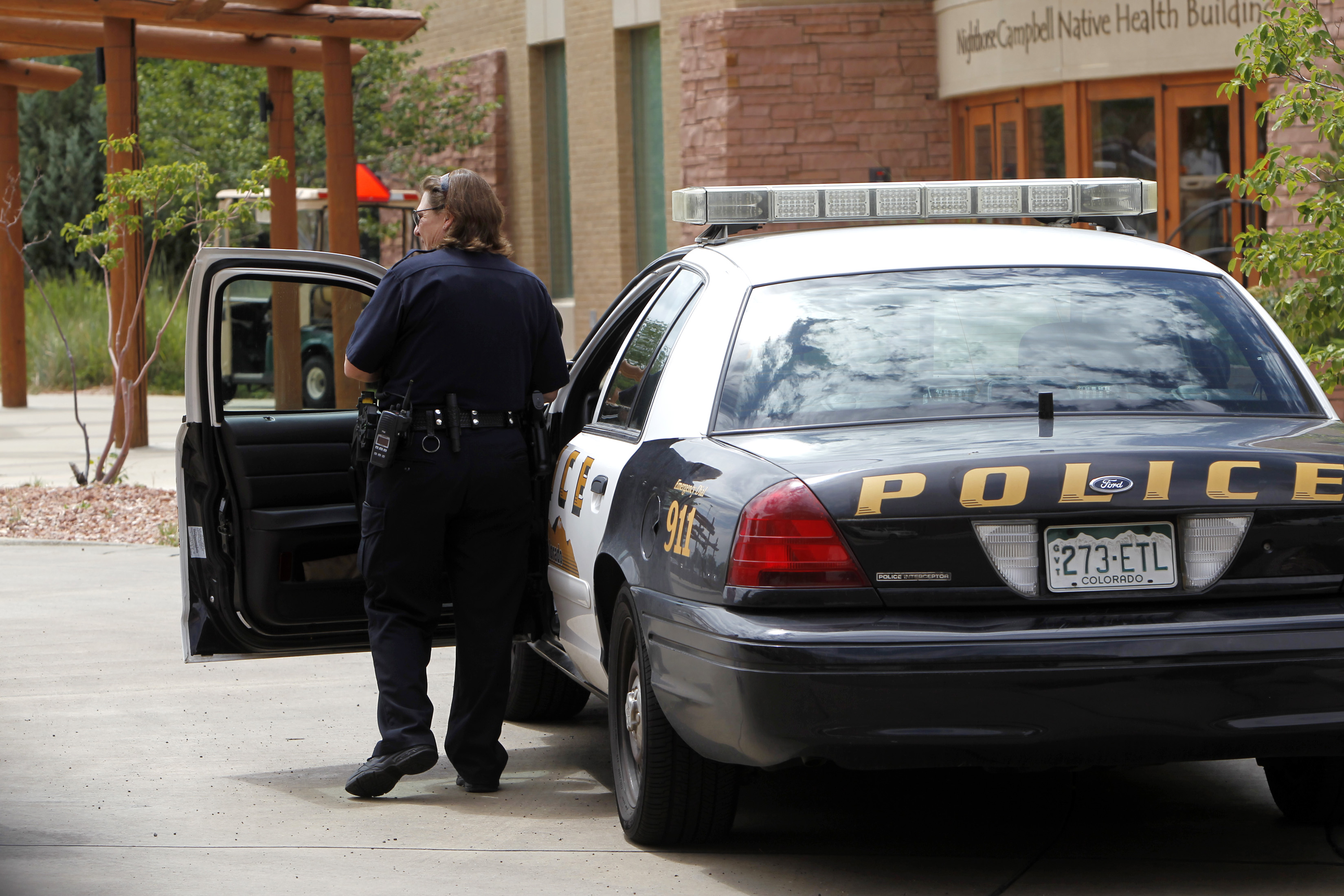 A University of Colorado police officer gets into her patrol car at the University of Colorado Medical Campus in Aurora, Colo. Suspected movie theater shooter James Holmes was studying neuroscience at the medical school and a psychiatrist there raised an alarm about his behavior. In the wake of a student's deadly attack at Virginia Tech five years ago, schools across the country put into place teams meant to bring together faculty and staff to notice and take action when a student appears to be a threat. The school won't say if campus police ever were alerted to Holmes, or whether faculty or staff ivestigated his behavior.
A University of Colorado police officer gets into her patrol car at the University of Colorado Medical Campus in Aurora, Colo. Suspected movie theater shooter James Holmes was studying neuroscience at the medical school and a psychiatrist there raised an alarm about his behavior. In the wake of a student's deadly attack at Virginia Tech five years ago, schools across the country put into place teams meant to bring together faculty and staff to notice and take action when a student appears to be a threat. The school won't say if campus police ever were alerted to Holmes, or whether faculty or staff ivestigated his behavior.By P. SOLOMON BANDA
Associated Press
DENVER - In the wake of the Virginia Tech tragedy five years ago, the University of Colorado and other schools across the U.S. created "threat assessment teams" to identify and take action against students who might turn violent. Now, in the aftermath of the movie theater rampage in Aurora, some are wondering whether the system broke down.
A Denver TV station reported this week that a university psychiatrist was so alarmed by graduate student James E. Holmes' behavior that she tried to bring him to the attention of the school's threat assessment team more than a month before the attack, but the group never met to talk about him because he had already taken steps to drop out.
Holmes, 24, is charged with murdering 12 people and wounding 58 in the July 20 rampage a few miles from the Aurora campus after methodically stockpiling guns and ammunition for months.
"If the argument is because he was no longer a student, he was no longer their problem, they are absolutely incorrect," said Larry Barton, a threat consultant and professor at American College in Bryn Mawr, Pa. "Any court and any victim's family would have an argument that the school acted with indifference. I hope they have a very compelling answer to why they did what they did."
University Chancellor Don Elliman has repeatedly said the school did all it could with regard to Holmes. He and other university officials have refused to discuss any specifics, citing privacy laws and a judge's gag order. The university would not say whether staff members had any concerns about Holmes or whether police were ever alerted to him.
However, KMGH-TV and the Denver Post, citing sources they did not identify, said police were never contacted.
It's not clear what alarmed the psychiatrist, Dr. Lynne Fenton, or whether she even treated him. But she helped found the school's Behavioral Evaluation and Threat Assessment Team in 2010.
The team's members are drawn from the counseling center, the faculty, the housing and student services departments and campus police. It consults with police, the university's legal team and mental health services.
It doesn't have the power itself to suspend or expel students or to force anyone to get mental health care. But it can refer students for voluntary care or school discipline and report threats to the authorities, the university said.
The idea of such teams is to bring all the warning signs together in one place.
"The end goal is to have coordinating systems, that different departments talk to each other," said Alison Kiss, executive director of the Clery Center for Security on Campus, which helps colleges and universities deal with security.
"People might act differently or say something during class, at a club or in a dormitory that might disclose different behaviors. It might not raise a concern when something's taken individually, but when you put them all together, they raise red flags."
Virginia passed a law in 2008 requiring its four-year public colleges to set up threat assessment teams to investigate students after a mentally unstable Seung-Hui Cho shot 32 people to death and committed suicide at Virginia Tech. The student had been sending out warning signs for years with his sullen behavior and twisted, violent writings.
Even if the Colorado team had convened and police investigated, it's unclear whether any violence could have been prevented.
In December, Morgan State University police and counselors in Baltimore evaluated student Alex Kinyua following an outburst in a computer lab and concluded he posed no threat. Months later he was charged with murdering a man and eating his heart and brain.
In Arizona, Pima Community College student Jared Loughner had several run-ins with faculty members, students and campus police before he was suspended in 2010. Campus police told him to get a mental health evaluation or not return.
Loughner was later arrested in the 2011 assassination attempt against Rep. Gabrielle Giffords that left six people dead.
